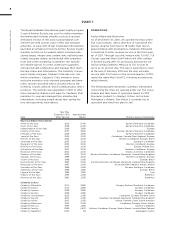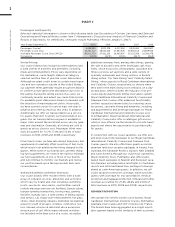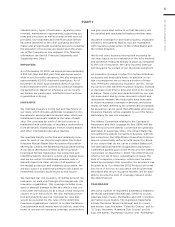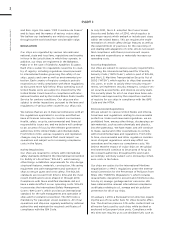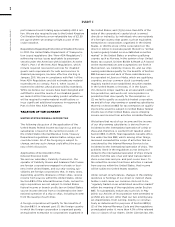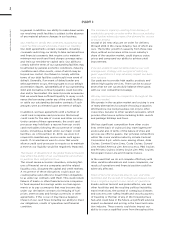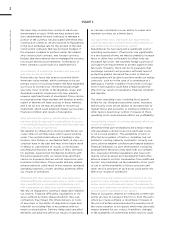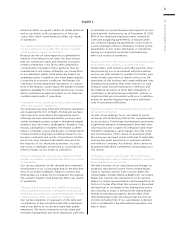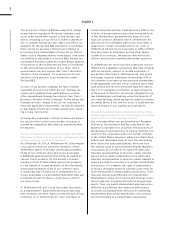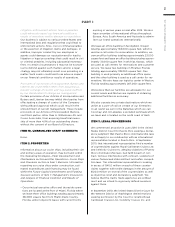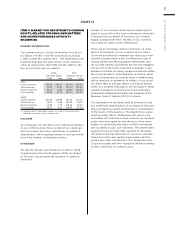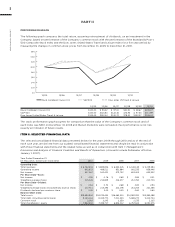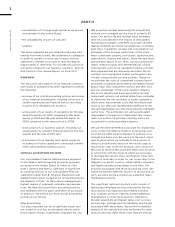Royal Caribbean Cruise Lines 2010 Annual Report Download - page 31
Download and view the complete annual report
Please find page 31 of the 2010 Royal Caribbean Cruise Lines annual report below. You can navigate through the pages in the report by either clicking on the pages listed below, or by using the keyword search tool below to find specific information within the annual report.
2010 ANNUAL REPORT 28
PART I
in general. In addition, our ability to make draws under
our revolving credit facilities is subject to the absence
of any material adverse changes in our business.
Our inability to satisfy the covenants required by our
credit facilities would adversely impact our liquidity.
Our debt agreements contain covenants, including
covenants restricting our ability to take certain actions
and financial covenants that require us to maintain
minimum net worth and fixed charge coverage ratios
and limit our net debt-to-capital ratio. Our ability to
comply with the terms of our outstanding facilities may
be affected by general economic conditions, industry
conditions and other events, some of which may be
beyond our control. Our failure to comply with the
terms of our debt facilities could result in an event of
default. Generally, if an event of default under any
debt agreement occurs, then pursuant to cross default
acceleration clauses, substantially all of our outstanding
debt and derivative contract payables could become
due and/or terminated. We cannot provide assurances
that we would have sufficient liquidity to repay or refi-
nance the borrowings under any of the credit facilities
or settle our outstanding derivative contracts if such
amounts were accelerated upon an event of default.
In addition, we have agreements with a number of
credit card companies and processors that accept
credit cards for the sale of cruises and other services.
Under certain of these agreements, the credit card
processor may hold back a reserve from our credit
card receivables following the occurrence of certain
events, including a default under our major credit
facilities. As of December 31, 2010, we were not
required to maintain any reserve under such agree-
ments. If circumstances were to occur that would
allow a credit card processor to require us to maintain
a reserve, our liquidity would be negatively impacted.
The impact of disruptions in the global financial markets
may affect the ability of our counterparties and others
to perform their obligations to us.
The recent severe economic downturn, including fail-
ures of financial service companies and the related
liquidity crisis, disrupted the capital and credit markets.
A recurrence of these disruptions could cause our
counterparties and others to breach their obligations
to us under our contracts with them. This could include
failures of banks or other financial service companies
to fund required borrowings under our loan agree-
ments or to pay us amounts that may become due
under our derivative contracts for hedging of fuel
prices, interest rates and foreign currencies or other
agreements. If this occurs it may have a negative
impact on our cash flows including our ability to meet
our obligations, results of operations and financial
condition.
The increase in capacity resulting from delivery of
newbuilds currently on order within the cruise industry
could further adversely impact the demand for cruises
or cruise pricing.
A total of 20 new ships are on order for delivery
through 2014 in the cruise industry, two of which are
ours. The further growth in capacity from these new
ships, without an increase in the cruise industry’s
share of the vacation market, could depress cruise
prices and compound our ability to achieve yield
improvement.
If we are unable to appropriately balance our cost
management strategy with our goal of satisfying
guest expectations it may adversely impact our busi-
ness success.
Our goals are to provide high quality products and
deliver high quality services. There can be no assur-
ances that we can successfully balance these goals
with our cost containment strategy.
We may lose business to competitors throughout the
vacation market.
We operate in the vacation market and cruising is one
of many alternatives for people choosing a vacation.
We therefore risk losing business not only to other
cruise lines, but also to other vacation operators, which
provide other leisure options including hotels, resorts
and package holidays and tours.
We face significant competition from other cruise
lines on the basis of cruise pricing, travel agent pref-
erence and also in terms of the nature of ships and
services we offer to guests. Our principal competitors
within the cruise vacation industry include Carnival
Corporation & plc, which owns, among others, Aida
Cruises, Carnival Cruise Lines, Costa Cruises, Cunard
Line, Holland America Line, Iberocruceros, P&O Cruises
and Princess Cruises; Disney Cruise Line; MSC Cruises;
Norwegian Cruise Line and Oceania Cruises.
In the event that we do not compete effectively with
other vacation alternatives and cruise companies, our
results of operations and financial position could be
adversely affected.
Fears of terrorist and pirate attacks, war, and other
hostilities and the spread of contagious diseases could
have a negative impact on our results of operations.
Events such as terrorist and pirate attacks, war, and
other hostilities and the resulting political instability,
travel restrictions, the spread of contagious diseases
and concerns over safety, health and security aspects
of traveling or the fear of any of the foregoing have
had, and could have in the future, a significant adverse
impact on demand and pricing in the travel and vaca-
tion industry. These events could also impact our
ability to source qualified crew from throughout the


